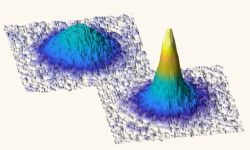
In the laboratory, physicists observe clouds of ultracold atoms in order to virtually dive into the interior of a neutron star or to return to the beginning of the universe. Certain quantum gases exhibit similar physical properties. A team led by Rudolf Grimm has now realized the first collisionally stable and strongly interacting mixed Fermi gas of two elements with different masses. They will use it to observe new superfluid states.
The world of fundamental particles can be distinguished into bosons and fermions. The fermion family includes electrons and quarks, but also composite particles consisting of an odd number of quarks, such as protons or neutrons. At temperatures near absolute zero, fermions reach a state in which they no longer interact with each other, forming a Fermi gas. However, when fermions join together to form pairs, they become bosons, which can interact very strongly with each other and thus form novel states of matter. One way to do this is to form molecules, which can then form a Bose-Einstein condensate. This was first created almost simultaneously in 2003 by the research groups led by Rudolf Grimm at the University of Innsbruck and Deborah Jin at JILA in Boulder. Fermions can also interact with each other over longer distances, as happens with electron pairs in superconductors.
Dysprosium and potassium
Ultracold gases are an excellent platform for investigating the properties of many-body systems in the laboratory. For some years now, mixed Fermi gases have been created from different elements. The difference in mass is the key to novel states of matter, but such systems have so far not been stable enough. Now the group led by Rudolf Grimm at the Department of Experimental Physics at the University of Innsbruck and the Institute of Quantum Optics and Quantum Information at the Austrian Academy of Sciences has succeeded for the first time in realizing a stable, strongly interacting fermion mixture of elements of different masses. They use isotopes of dysprosium and potassium.
Fermion mixture
The atomic mixture, cooled down to a few billionths of a degree in a tiny cage of laser light, is transformed into a strongly interacting Fermi gas by means of a strong magnetic field, with which the researchers can alter the attraction between the atoms as desired. Rudolf Grimm's team has discovered a so-called Feshbach resonance, where the magnetic field can be used to create the necessary interaction between the particles. As previously only observed with particle mixtures of the same mass, the system is proving to be very stable. "The particles show a strong interaction and the lifetime of the mixture is very long," enthuses Rudolf Grimm. "These are exactly the prerequisites for investigating long sought-after new superfluid states." Grimm's team now wants to further investigate these states in their experiment. This is of interest as Fermi gases can be used as a model for many phenomena in nature, such as the state inside neutron stars, matter a few microseconds after the Big Bang or high-temperature superconductivity.
The results of the research group headed by Rudolf Grimm have now been published in the journal Physical Review Letters. The work was financially supported by the Austrian Science Fund FWF.